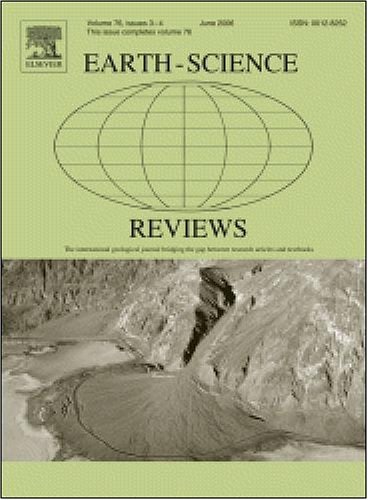Carbon capture and storage via enhanced carbonate weathering coupled with aquatic photosynthesis: Potential, cost, and advantages
IF 10
1区 地球科学
Q1 GEOSCIENCES, MULTIDISCIPLINARY
引用次数: 0
Abstract
The application of crushed rock powders to terrestrial or marine ecosystems (termed enhanced rock weathering, ERW) is regarded as an effective carbon dioxide removal (CDR) mechanism for mitigating ongoing climate change. As a potential ERW material, carbonate is characterized by rapid dissolution kinetics and is environmentally friendly. However, the CDR potential, cost, and effectiveness of carbonate-based ERW implementation are not well explored. Using a carbonate equilibrium equation, and the CMIP6 (Coupled Model Intercomparison Project Phase 6) GCM (Global Climate Model) and LCA (Life Cycle Assessment) models, here we analyze the CDR potential, carbon footprint, and cost of a carbonate-based RW strategy (so-called enhanced carbonate weathering, ECW). We estimated that the current global potential carbon removal (PCR) of ECW could reach ∼2.66 (Representative Concentration Pathway (RCP) 4.5) and ∼ 2.82 (RCP8.5) Gt CO2 a−1, and that the cumulative CO2 removal by the end of this century could reach 241.32 Gt CO2 a−1 (RCP4.5) and 246.64 Gt CO2 a−1 (RCP8.5). This could potentially neutralize ∼23.11 % (RCP4.5) and ∼ 23.62 % (RCP8.5) of future global carbon dioxide emissions. We also found that the global CDR potential of ECW can respond sensitively to global environmental perturbations, and that the CDR potential in the future will generally increase in high-latitude regions due to global climate change. We compared the cost of enhanced silicate weathering (ESW) with ECW implementations for seven major countries with high CDR potential and found that the cost per mol of CO2 removal by ECW is 1.33–2.07 times lower than that for ESW. While the stability of dissolved inorganic carbon (DIC) is debated in many studies, we suggest that the new approach represented by ECW should consider the role of aquatic photosynthesis. Overall, the biological pump induced by aquatic photosynthesis is significant for increasing the carbon storage of ECW in inland waters. For future ERW implementation, we stress the need to develop an Enhanced Coupled Carbonate Weathering plus aquatic photosynthesis strategy (ECCW) that can both offset the negative effect of CO2 degassing and also increase the total CDR of ECW to a greater degree than expected. ECCW remains in the developmental stage, and its large-scale implementation requires further laboratory and field experiments to determine its CDR-efficiency and environmental effects and risks.
通过增强碳酸盐风化和水生光合作用进行碳捕获和储存:潜力、成本和优势
将碎石粉末应用于陆地或海洋生态系统(称为增强岩石风化,ERW)被认为是一种有效的二氧化碳去除(CDR)机制,可以缓解持续的气候变化。碳酸盐具有溶解速度快、环境友好等特点,是潜在的战争遗留材料。然而,碳酸盐基战争遗留武器的CDR潜力、成本和有效性尚未得到很好的探索。本文利用碳酸盐平衡方程和CMIP6(耦合模式比对项目第6阶段)GCM(全球气候模式)和LCA(生命周期评估)模型,分析了基于碳酸盐的RW策略(所谓的增强碳酸盐风化,ECW)的CDR潜力、碳足迹和成本。我们估计,目前ECW的全球潜在碳去除率(PCR)可达到~ 2.66(代表性浓度路径(RCP) 4.5)和~ 2.82 (RCP8.5) Gt CO2 a - 1,到本世纪末累计CO2去除率可达到241.32 Gt CO2 a - 1 (RCP4.5)和246.64 Gt CO2 a - 1 (RCP8.5)。这可能潜在地中和未来全球二氧化碳排放量的~ 23.11% (RCP4.5)和~ 23.62% (RCP8.5)。研究还发现,ECW的全球CDR位能对全球环境扰动做出敏感响应,未来高纬度地区的CDR位能将普遍受到全球气候变化的影响而增加。我们比较了七个具有高CDR潜力的主要国家实施增强硅酸盐风化(ESW)和ECW的成本,发现ECW每mol CO2脱除成本比ESW低1.33-2.07倍。虽然溶解无机碳(DIC)的稳定性在许多研究中存在争议,但我们建议以ECW为代表的新方法应该考虑水生光合作用的作用。综上所述,水生光合作用诱导的生物泵对增加内陆水域ECW的碳储量具有重要意义。对于未来的生态环境保护实施,我们强调需要开发一种增强的碳酸盐风化和水生光合作用耦合策略(ECW),既可以抵消二氧化碳脱气的负面影响,又可以将ECW的总CDR提高到比预期更大的程度。ECCW仍处于发展阶段,其大规模实施需要进一步的实验室和现场试验,以确定其cdr效率、环境影响和风险。
本文章由计算机程序翻译,如有差异,请以英文原文为准。
求助全文
约1分钟内获得全文
求助全文
来源期刊

Earth-Science Reviews
地学-地球科学综合
CiteScore
21.70
自引率
5.80%
发文量
294
审稿时长
15.1 weeks
期刊介绍:
Covering a much wider field than the usual specialist journals, Earth Science Reviews publishes review articles dealing with all aspects of Earth Sciences, and is an important vehicle for allowing readers to see their particular interest related to the Earth Sciences as a whole.
 求助内容:
求助内容: 应助结果提醒方式:
应助结果提醒方式:


